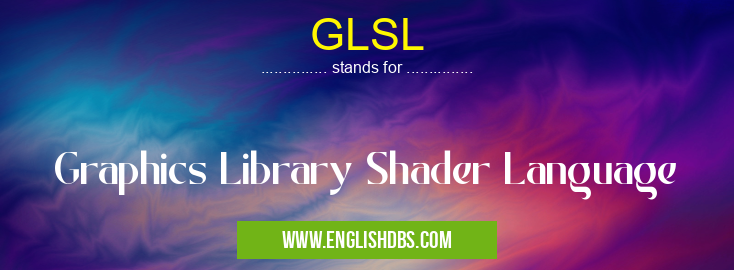What does GLSL mean in LANGUAGE & LITERATURE
GLSL stands for Graphics Library Shader Language and is a high-level shading language designed specifically for graphics programming. It is used to write shaders, which are small programs that run on the GPU (Graphics Processing Unit) to enhance the visual effects of 3D graphics.

GLSL meaning in Language & Literature in Academic & Science
GLSL mostly used in an acronym Language & Literature in Category Academic & Science that means Graphics Library Shader Language
Shorthand: GLSL,
Full Form: Graphics Library Shader Language
For more information of "Graphics Library Shader Language", see the section below.
Key Features of GLSL
- Platform Independent: GLSL is supported by various graphics APIs and platforms, including OpenGL and Vulkan, making it widely accessible.
- Procedural Shading: It enables developers to define complex lighting, texturing, and other visual effects through programmatic means.
- Flexibility: GLSL provides a wide range of built-in functions and data types tailored for graphics applications, allowing for versatile shader creation.
- Performance Optimization: Shaders written in GLSL are compiled into efficient machine code, utilizing the parallel processing capabilities of GPUs.
Applications of GLSL
GLSL finds applications in a variety of fields, including:
- 3D Graphics: Creating realistic lighting, textures, and special effects in video games, movies, and simulations.
- Image Processing: Enhancing images through filters, color correction, and other image manipulation techniques.
- Scientific Visualization: Generating scientific data visualizations and simulations with advanced visual effects.
Essential Questions and Answers on Graphics Library Shader Language in "SCIENCE»LITERATURE"
What is GLSL?
GLSL (Graphics Library Shader Language) is a high-level shading language used in computer graphics to create and modify 3D graphics on graphics cards. It is used to write shaders, which are programs that execute on the graphics card and control how objects are rendered.
What are the uses of GLSL?
GLSL is used in a wide range of applications, including:
- Creating realistic visual effects in video games
- Rendering complex scenes in movies and animations
- Developing scientific and medical visualizations
- Manipulating images and textures in photo editing and image processing applications.
What are the benefits of using GLSL?
GLSL offers several benefits, including:
- Increased performance: GLSL shaders can be optimized for specific graphics hardware, resulting in improved performance and efficiency.
- Greater control: GLSL gives developers more control over the rendering process, allowing them to create more complex and realistic graphics.
- Portability: GLSL is supported by a wide range of graphics cards and platforms, ensuring that shaders can be used across different systems.
How do I learn GLSL?
There are several resources available for learning GLSL:
- Tutorials: Numerous tutorials are available online, covering both the basics and advanced concepts of GLSL.
- Documentation: The official GLSL documentation provides a comprehensive reference for the language.
- Community forums: Online forums and communities provide support and resources for GLSL developers.
- Courses: Some colleges and universities offer courses in GLSL and computer graphics.
Final Words: GLSL is an essential language in the realm of graphics programming, providing developers with the tools to create visually stunning and computationally efficient 3D graphics. Its platform independence and flexibility make it a versatile choice for a wide range of applications, from video games to scientific visualization. As the demand for high-quality graphics continues to grow, GLSL will undoubtedly remain a crucial component of the graphics technology stack.
